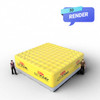Airbags for Fall Protection: Redefining Workplace Safety
In the realm of workplace safety, advancements in technology have continuously reshaped our approach to preventing accidents and minimizing risks. One such innovation that has significantly transformed fall protection is the use of airbags. Originally designed for automotive safety, airbags have found a new purpose in safeguarding workers at heights.
The Origins and Adaptation:
Airbags have a storied history dating back to the mid-20th century, primarily as a passive restraint system in automobiles. Their rapid inflation upon collision reduces the risk of injury by cushioning the impact and preventing occupants from striking hard surfaces within the vehicle. This concept of rapid inflation and energy absorption laid the groundwork for their adaptation into fall protection systems.
Recognizing the potential of airbag technology in workplace safety, innovators began adapting it for use in industries where falls from heights pose significant risks. Construction, entertainment, adventure sports, and maintenance sectors are among those embracing airbag fall protection systems.
Design and Functionality:
Modern airbag fall protection systems consist of inflatable cushions housed within durable enclosures. These enclosures are strategically positioned at ground level or mounted on elevated platforms, ready to deploy when needed. The deployment mechanism typically involves sensors that detect sudden changes in acceleration or orientation, triggering the inflation process milliseconds before impact.
Upon activation, the airbags rapidly inflate, expanding to cushion the fall of the worker. The design ensures even distribution of force, reducing the risk of injuries such as fractures, concussions, and spinal trauma. Many systems also incorporate features such as multiple chambers to enhance stability and adjustability, allowing for optimal protection across various heights and fall scenarios.
Benefits of Airbag Fall Protection:
The adoption of airbag systems for fall protection offers numerous advantages over traditional methods:
- Enhanced Safety: Airbags provide superior shock absorption, reducing the risk of serious injuries associated with falls from heights.
- Versatility: Unlike fixed systems like nets, airbags can be easily repositioned and adapted to different worksites and scenarios.
- Minimal Maintenance: With fewer moving parts compared to mechanical systems, airbags require less maintenance and upkeep, resulting in lower operational costs.
- Worker Confidence: The presence of airbag fall protection instills confidence among workers, allowing them to focus on their tasks without the constant fear of falling.
Industries Utilizing Airbag Fall Protection:
Airbag fall protection systems have gained traction across various industries where working at heights is commonplace:
- Construction: From scaffolding to steel structures, airbags offer reliable protection for workers on construction sites, reducing the risk of injuries from falls.
- Entertainment: Stunt performers and aerial artists rely on airbags to cushion their landings during rehearsals and live performances, ensuring a safe environment for creativity.
- Adventure Sports: In activities like rock climbing and high-altitude trampolining, airbags serve as crucial safety measures, allowing participants to push their limits without compromising on safety.
- Maintenance and Inspection: Workers tasked with maintenance and inspection of tall structures, such as wind turbines and communication towers, benefit from the portable and adaptable nature of airbag fall protection.
In conclusion, airbag fall protection represents a significant advancement in workplace safety, offering dynamic, reliable protection for individuals working at heights. By prioritizing the implementation of advanced fall protection measures, we not only safeguard the well-being of workers but also pave the way for greater productivity and innovation in the workplace.


















